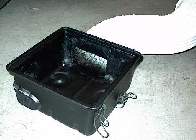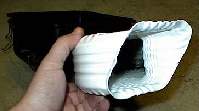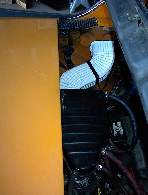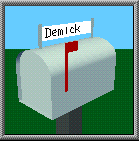4HP FOR $4
COLD AIR INTAKE REDUCES TEMPS, MAKES POWER!
Years ago I did some air temperature tests to see how much air entering the
engine compartment is preheated before even getting to the fan for engine
cooling. So I wired up some thermocouples to test this and put a
thermocouple just inside the intake for the air cleaner to measure that air
temperature as well. I was astounded to find how much air preheat occurs
for air making it's way into the air cleaner. After taking a closer look
at the stock setup, it is not really that hard to imagine. The air intake
snorkel on my '74 2.0 is located in probably the hottest area of the engine
compartment (at the center rear of the engine compartment). This area
receives essentially no fresh air since there is no air inlet anywhere
near that point (it is important to note that my car has the rain tray
installed). All of the fresh air entering the engine compartment comes
in through the engine lid grill and then exits the rain tray toward the
front of the engine compartment where it is sucked down toward the cooling
fan. The stock air cleaner inlet has to suck air from the rear of the
engine compartment, which means that the air has to pass over the hot
engine in order to get there - preheating that air by anywhere from 40
to 80 degrees Fahrenheit!!
Now everyone knows that cooler air is better and makes more power. I
had heard that a general rule of thumb is that for every 10F decrease, your
engine can make up to 1% more horsepower - so I knew that there was
some serious HP to be gained here (yes, when you only have 95HP, 4 or 5
additional HP is indeed considered serious).
I autocross my 914 regularly, so I read the rule book on what
modifications I was allowed to make in my class designation (I run in PCA Zone 7
using the Golden Gate Region rule book, Class Bi). The rules read as
follows:
4.2(e) Air Cleaner Element: Any air cleaner element may be used. The
stock element housing must be retained, but the pre-filter portion of the
housing may be drilled to allow greater airflow. The drilling may not
completely compromise the structural integrity of the air cleaner housing. These
changes allow easier engine breathing without putting the engine at
risk of unfiltered air.
Working within these rules I determined that I could drill a really big
hole into the pre-filter portion of the housing and attach attach a new
intake snorkel (and I figured that plugging the old snorkel was within
the rules as well). I wanted the new snorkel to be plenty big to not
restrict any airflow (the stock snorkel seemed a bit small to me). I also
determined that probably the coolest areas of the engine compartment
would be at either end (near the battery or the relay plate) or near the
front of the engine compartment near where the fresh air exits the rain tray. I
chose to go for the area right above the relay plate. Since I do drive
my car in the rain, it was important that my cold air intake be
rain-proof, which is why I did not duct the cold air intake directly into the grill
to the side of the engine lid.
Below is the cold air intake system that I came up with.

I used two plastic 4"x5" 45 degree downspout elbows that I got for
around $2 each at the local hardware store. I cut an appropriate hole in the
air cleaner housing to attach one of the elbows, and fiberglassed it into
place. I had the fiberglassing materials at home, but you can get a
starter kit from any auto parts store for around $10. One piece of
advise is that most of these starter kits come with fiberglass mat which is
not well suited for this type of work (too stiff). Be sure to get some
fiberglass cloth instead as it is much easier to work with and will
conform to the surface better.

Then I cut off the old snorkel and plugged that opening with fiberglass
as well (although you could leave the old snorkel in place and plug it
with whatever you want, or maybe even just flatten it in a vice or something
to plug it up). The picture below shows the stock intake on the left and the new
intake on the right. Note that the two intakes shown have the same orientation
(the cold air intake snorkel sticks out the opposite side of the plenum).

At this point I was pretty much done. The 2nd downspout elbow simply
slips over the one attached to the air cleaner and I secure it with a piece
of tape. I haven't figured out how I want to secure it long term, but I
don't want to glue it in place because I want to be able to easily remove it
for access to the relay plate (I don't have a relay plate cover installed).
I cut the inlet end of the elbow at an angle to prevent water from
running in, and then flared it using a heat gun and the back side of a spoon.

Here is a picture of it installed in the car.

That's it! But does it really work?
TEMPERATURE TESTS
To determine if the cold air intake setup really works, I ran some comparison
tests (numbers represent the temperature above outside air temperature):
STOCK INTAKE
Idle: +50F
Driving: +61F
COLD AIR INTAKE
Idle to 40mph: +0 to 5F
75mph, 3Krpm: +23F
75mph, 4Krpm: +13F
With the stock setup, the inlet temperature was not very susceptible to
engine speed or vehicle speed. It was pretty constant averaging 61F
above outside air temperature, but did seem to run a bit cooler when at idle
(like anyone cares about that).
With the new cold air intake, the inlet temperature changes with engine
speed and vehicle speed. At speeds below about 40mph, the inlet temps
were 5 degrees or less above ambient. At higher vehicle speeds, the
temperature climbs. I believe that this is because the area behind the rear
window is a low pressure area which actually tries to suck air out of the engine
compartment, so rather than the air filter inlet being able to suck
fresh air directly from the grill above it, it gets more mixed air coming
from other areas of the engine compartment. I did also find that at higher
speeds, if the engine RPM's were raised, that the inlet temps
dropped. This is because the engine cooling fan is actively sucking more
air at higher RPM's, and not allowing as much of the 'general engine
compartment preheated air' to make it's way over to the air cleaner intake.
All in all, the results were pretty amazing. I dropped an average of
50F off of the intake air temperatures. That's huge. The formula for how
engine power is affected by air temperatures (normalized for an average
of 20C) is:

Note that temperatures are in Celsius. A 50F temp drop is equivalent
to a 28C temp drop. Plugging that through the formula, I get a 4.7%
increase in engine power! On my lowly 95HP car, that's worth 4.4 horses!
So am I really getting 4.4 extra horsepower with this setup? Who
knows. I think it is optimistic and am not going to spring for a day on the dyno
to find out. But I decided to run some acceleration tests to see if I
could measure a difference.
ACCELERATION TESTS
My acceleration test was based on timing my acceleration in 3rd gear
from 3K to 5K rpm. I set up on a straight level road, got the car going in
3rd gear at around 2.5K RPM, floored it, and timed with a stopwatch how
long it took to go from 3K to 5K RPM. I did 4 runs (2 in each direction on the
same section of road) and averaged the times. First with the stock
setup, and then with the cold air intake setup. Both setups were tested
within 5 minutes of one another with a fully warmed up engine, same outside air
temp, same amount of fuel in the car, etc.
With the stock setup, my times averaged 6.56 seconds. With the cold air
intake setup, my time averaged 6.21 seconds. A drop of .35 seconds, or
5.3% increase in acceleration! I have won or lost autocrosses by less
than this amount of time. This proved to me that the cold air intake system
really does make power! Maybe even the 4 or so horsepower that I calculated.
Just for interest, I then removed the stock air cleaner element (it was
new just before this set of tests) to see how restrictive the stock paper
element is. Guess what, no measurable increase in acceleration
(actually, the times averaged .01 seconds faster, but that difference is not
within the accuracy of this test). So this reinforced what I had heard before
that the stock element is very efficient - at least on a stock motor.
So I don't think I will be springing for a K&N anytime soon.
Good luck and have fun!
 demick@yahoo.com
demick@yahoo.com





